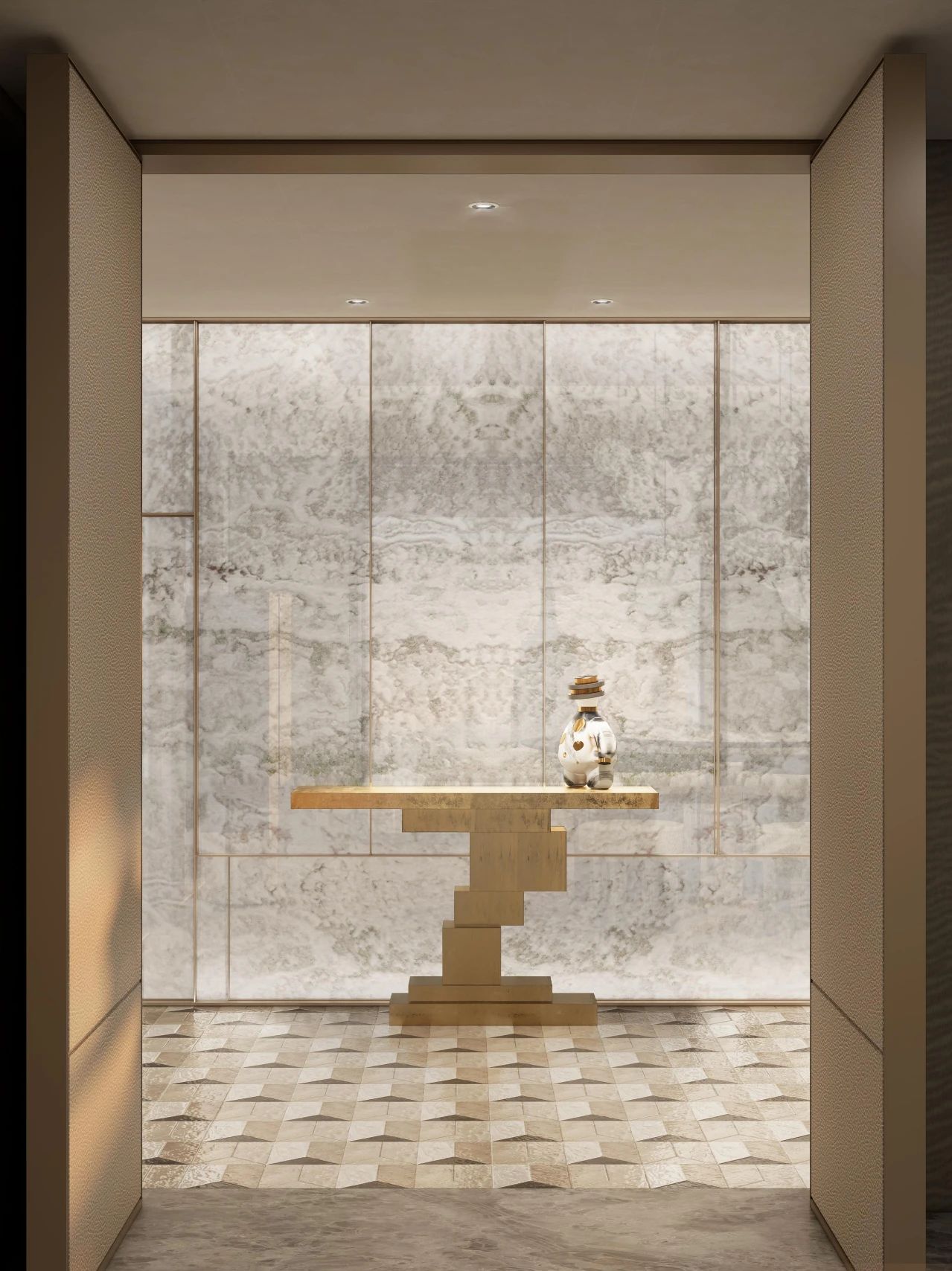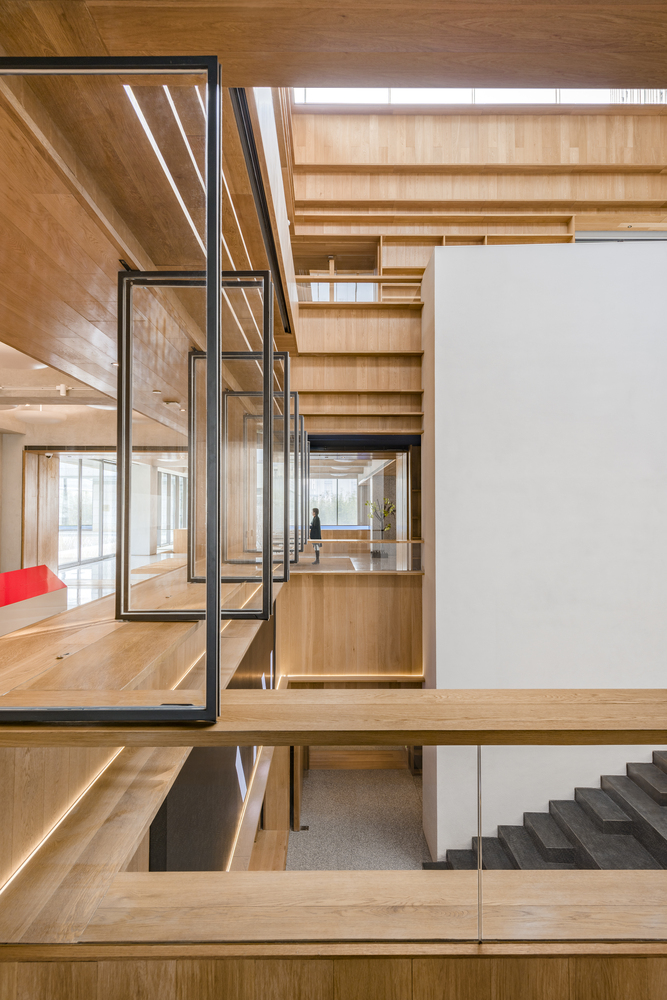Chapulín mob + SAMA arquitectos
2015-07-10 20:00
架构师提供的文本描述。Chapul N概念是由SAMA建筑师和暴民提出的,融合了墨西哥历史上的特色元素。这是一个灵感来自墨西哥古代传统精髓的空间,被翻译成当代语言。
Text description provided by the architects. CHAPULÍN concept was conceived by SAMA Architects and mob, fusing characteristic elements of Mexico’s history. It is a space inspired in the essence of ancient Mexican traditions, translated into a contemporary language.
萨玛和黑帮计划通过各种材料的有趣的选择来配合室内设计,这些材料渗透并强调了餐厅中的每一个不同的区域。主入口有一个独特的走廊,由一组瓦哈卡州的瓦哈卡妇女手工制作,由墨西哥艺术家和雕塑家阿丹·帕雷德斯(Adan Paredes)经营的“El Alacrán”陶瓷车间手工制作,由1.1万多块定制粘土瓷砖组成。这些瓷砖是经过战略设计的,以适应走廊两侧弯曲的墙壁,从而在酒店的门厅和餐厅的大堂之间形成了一个过渡性的空间。
SAMA and mob planned interiors to be conformed by a playful selection of various materials, which altogether permeate and emphasize each of the different areas in the restaurant. The main entrance welcomes us with a unique hallway, made up by a fixing of more than 11,000 custom clay tiles, made by hand in the state of Oaxaca by a group of Oaxacan women in “El Alacrán” ceramics workshop, run by Mexican artist and sculptor Adan Paredes. The tiles were strategically designed in order to fit into the curved walls along the corridor, thus generating a transitional space between the hotel’s foyer and the restaurant’s lobby.
当菜肴和梅兹卡尔的香味升起时,一幅由千变万化数字马赛克组成的壁画艺术品迎接着顾客。这幅作品由视觉艺术家Ignacio Rodríguez Bach制作,并呈现了代表餐厅所在的Chapultepec地区的一系列图像。Chapulín是当地蝗虫种的墨西哥名字,Chapultepec在Nahuatl中的意思是“Chapulines的山”,这是现存的最著名的墨西哥土著语言。
As the scents from the dishes and mezcal arise, a mural art piece consisting of kaleidoscopic digital mosaics greets the customers. This piece was made by visual artist Ignacio Rodríguez Bach and presents a series of images representative of the Chapultepec area, where the restaurant is located. Chapulín (chapulines in plural) is the Mexican name for a local species of grasshopper, and Chapultepec means “hill of the chapulines” in Nahuatl, the most prominent ancient Mexican native language which still survives.
装饰在木材和柳条编织,几何口音和朴素元素是一些细节,使餐厅休息室。酒吧区可以方便地从大堂到达,其特点是使用大理石、花岗岩和玻璃等冷外观材料;与木制墙板和吊顶形成对比,使墨西哥昔日殖民时代的优雅重新焕发生机。
Finishes in wood and wicker weaving, geometric accents and basketry elements are some of the details that dress up the diner lounge. The bar area can be easily reached from the lobby, and is characterized by the use of cold appearance materials such as marble, granite and glass; wich in contrast with the wooden wall panels and suspended ceiling, bring back to life the elegance of old colonial times in Mexico.
除了这一空间,游客还可以享受餐厅,餐厅由暴民工作室专门设计的一系列桌椅组成:皮革软垫凳子,带有柳条编织靠背的椅子,以及受前哥伦布文化启发的几何图形装饰表面。
Aside this space, visitors can enjoy the dining area which is conformed by a series of tables and chairs designed exclusively for the project by mob studio: leather upholstered stools, chairs with wicker weaved backrests and geometric pattern decorated surfaces inspired by pre-Columbian cultures.
由于暴民擅长室内建筑和家具设计,所有的家具都是由手工艺大师制作的,以在空间内实现全面和连贯的外观。餐厅是最宽敞的,它被划分为两个不同的空间:露台和内休息室,两处景观都是沙普尔特派克森林的壮丽景观,通过一个大的透气窗口,可以让自然通风和阳光进入,这要归功于它的折叠系统。
As mob specializes in interior architecture and furniture design, all pieces of furniture were made by master craftsmen to achieve a comprehensive and coherent look within the space. Being the most spacious, the dining area is at a time divided in two different spaces: terrace and inner lounge, both having the magnificent sight of Chapultepec forest as landscape, through a large permeable window that allows for natural ventilation and sunlight access, thanks to its folding system.
位于建筑群的左端,有一个专门为主厨准备的私人房间。它的拱形天花板覆盖着黑白釉瓷砖的图案排列,沿着墙一直延伸到厨房的极限。这个房间是为了让食客直接品尝厨师的美味,建立起一种更私人的关系。在对面,空间扩展为一个专用的私人餐厅,提供所有必要的便利设施来举办亲密活动。
Located in the left end of the complex there is a private room specially destined for the Chef. Its vaulted ceiling is covered with a patterned arrangement of black and white glazed ceramic tiling, which is continued along the walls up to the kitchen limits. This room was created for the diners to savor the Chef’s delicacies directly, establishing a more personal relation. In the opposite side, the space is extended into an exclusive private dining room, with all the necessary amenities to host intimate events.
房间中央有一张宽餐桌,可容纳25人。暗示西班牙前金字塔形状的图案在天花板上反复出现,在这一地区的另一边,有一个小客厅,从那里可以到达露台和反射池。
In the middle of the room, a wide dining table that accommodates 25 people is found. Motifs alluding to the shapes of pre-Hispanic pyramids are repeated in the ceiling and on the far side of this area, there is a small living room from where the terrace and reflecting pool can be reached.
最后但并非最不重要的是,酒窖就在入口大厅旁边。这一空间的设计特别是为了容纳各种各样的葡萄酒和梅斯卡尔品牌提供的餐厅,为此,木制架子是在整个墙壁。在房间的中央有一套特殊的家具,由一个橱柜和一个挂在天花板上的灯具组成,展示了一些最豪华的葡萄酒。Chapulín餐厅是一家集墨西哥传统和精致烹饪品味于一体的餐厅,一种旨在激发所有感官的体验。
At last but not of least importance, next to the entrance hall the wine cellar is located. This space was particularly designed to house the wide variety of wine and mezcal brands offered in the restaurant; for this, wooden shelvings were built throughout the walls. In the center of the room there is a special furniture set made up by a display cabinet and a hanging luminaire that descends from the ceiling, showcasing a selection of the most luxurious wines. Chapulín is a restaurant that brings together Mexican tradition and refined culinary taste, an experience meant to stimulate all senses.
 举报
举报
别默默的看了,快登录帮我评论一下吧!:)
注册
登录
更多评论
相关文章
-

描边风设计中,最容易犯的8种问题分析
2018年走过了四分之一,LOGO设计趋势也清晰了LOGO设计
-

描边风设计中,最容易犯的8种问题分析
2018年走过了四分之一,LOGO设计趋势也清晰了LOGO设计
-

描边风设计中,最容易犯的8种问题分析
2018年走过了四分之一,LOGO设计趋势也清晰了LOGO设计










































































